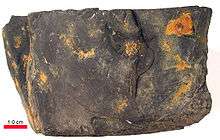Coal oil

Coal oil is a shale oil obtained from the destructive distillation of cannel coal, mineral wax, or bituminous shale, once used widely for illumination.
Chemically similar to the more refined, petroleum-derived kerosene, it consists mainly of several hydrocarbons of the alkane series, with 10 to 16 carbon atoms in each molecule and a higher boiling point (175–325 °C) than gasoline or the petroleum ethers and lower than the oils.
The term was in use by the late 18th century, for oil produced as a byproduct of the production of coal gas and coal tar.[1] In the early 19th century it was discovered that coal oil distilled from cannel coal could be used in lamps as an illuminant, although the early coal oil burned with a smokey flame, so that it was used only for outdoor lamps; cleaner-burning whale oil was used in indoor lamps.[2]
Coal oil that burned cleanly enough to compete with whale oil as an indoor illuminant was first produced in 1850 by James Young on the Union Canal in Scotland, who patented the process. Production thrived in Scotland, creating much wealth for Young.
In the United States, coal oil was widely manufactured in the 1850s under the trade name Kerosene, manufactured by a process invented by Canadian geologist Abraham Gesner. Young triumphed in his patent lawsuit against the Gesner process in the United States in 1860. But by that time, US coal oil distillers were switching over to refining cheaper petroleum, after the discovery of abundant petroleum in western Pennsylvania in 1859, and oil from coal operations ceased in the US.
Because kerosene was first derived from cannel coal, classified as terrestrial type of oil shale,[3] it continued to be popularly referred to as "coal oil" even after production shifted to petroleum as a feedstock.[4][5][6] Technically, refined hydrocarbons of the alkane series with 10 to 16 carbon atoms are the same thing whether taken from coal or petroleum.
Uses
Lighting
Coal oil has been used to provide lighting.[7][8]
As cure-all
Coal oil was once used as an internal and topical home remedy as a general cure-all for many ailments, including coughs, flu, cuts, abrasions, and wounds. Internal applications were administered by adding this toxic petroleum product to sugar cubes, molasses, honey or some other substance to mask the taste, while topical applications were applied adding to bandages or by pouring the coal oil directly on the affected area.[9]
See also
- Patent medicine
- Abraham Pineo Gesner, produced kerosene from coal, 1846
- Shale oil extraction
References
- ↑ Account of the qualities and uses of coal tar and coal varnish, Scots Magazine, May 1784, v.46 p.240-242.
- ↑ Frederick Accum, Description of the Process of Manufacturing Coal Gas, 2nd ed. (London: Thomas Boys, 1820) 301.
- ↑ Dyni (2006), pp. 3–4
- ↑ Evelyn Richardson (20 October 2009). "Here and There: Call It Coal oil or kerosene, Fuel Still Has Its Uses". Logan County (Kentucky) News-Democrat & Leader. Retrieved 9 January 2011.
- ↑ Maris, Clarence (1921). "Lesson 4, The Coal Oil or Kerosene Lamp.". Dangers and chemistry of fire, for grammar schools. Columbus, Ohio: The F.J. Heer Printing Company. Retrieved 9 January 2011.
- ↑ Drake, Paul (2004). "Definition of "coal oil" as common term for kerosene". What Did They Mean By That? A Dictionary of Historical and Genealogical Terms, Old and New. Heritage Books, Inc. p. 60. ISBN 978-0-7884-2500-4. Retrieved 9 January 2011.
- ↑ N.Y.), James M. Nichols (New York,; Orr, John William; Club, Rushlight (2010). Illustrated Catalogue of Lamps, Brackets, Chandeliers & Fixtures, for Coal Oil, Railroad, Steamboat, and House Lanterns. Rushlight Club.
- ↑ Wetherill, Charles Mayer (1860). On the relative cost of illumination in Lafayette, Ind. American gas-light journal.
- ↑ Delbert Trew (15 June 2007). "Coal Oil Was Useful All-Purpose Home Remedy". Texas Escapes. Blueprints For Travel, LLC. Retrieved 9 January 2011.